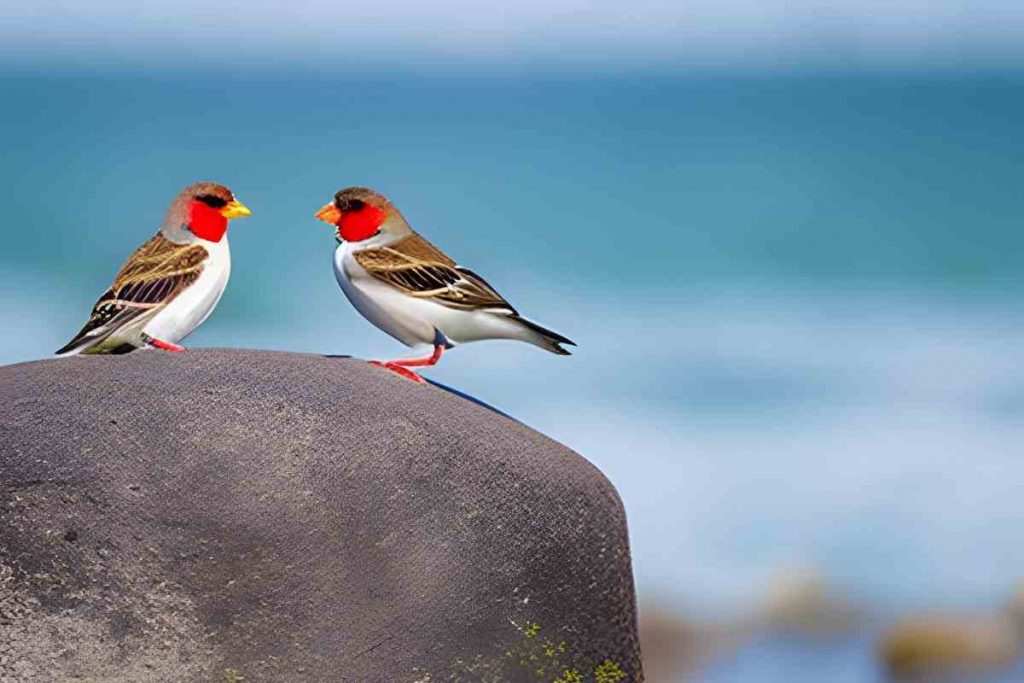Today, we’re diving into the fascinating world of finches living on the Galapagos Islands. These small but mighty birds have captured the attention of scientists and birdwatchers alike for generations with their incredible adaptability and unique physical characteristics. Join us as we explore what makes these feathered friends so special and how they’ve managed to thrive in one of the most remote and challenging environments on Earth. Get ready to be amazed by these delightful creatures!
Galapagos Finches: Evolution and Adaptations
The Galapagos Islands are home to many unique species of animals, including the Galapagos finch. These finches are small songbirds that are closely related to sparrows. There are 13 different species of Galapagos finches, each with its own unique plumage, song, and behavior.
The different types of Galapagos finches are thought to have evolved from a single ancestral species that arrived on the islands millions of years ago. The isolation of the islands allowed these different species to develop over time. The different types of finches now occupy different niches on the islands, such as feeding on different types of food or nesting in different places.
One of the most famous examples of adaptive radiation is the case of the Galapagos finches. These birds were first studied by Charles Darwin during his visit to the Galapagos Islands in 1835. He observed that there were several distinct varieties of finches, each adapted to a specific style of feeding. For example, some finches had long beaks for probing flowers for nectar, while others had short beaks for eating seeds.
Darwin’s observations led him to develop his theory of natural selection, which states that organisms adapt to their environment in order to survive and reproduce. The Galapagos finches continue to provide scientists with an important example of how evolution can occur.
Habitat and Diet of Galapagos Finches
The Galapagos finches are a group of closely related songbirds that live on the Galapagos Islands. The different species of finches occupy different habitats and eat different foods, but all are adapted to the harsh conditions of the islands.
The small ground finch (Geospiza fuliginosa) is found in open areas with short grasses, where it searches for seeds and insects. The large ground finch (Geospiza magnirostris) is found in dry forests and scrublands, where it eats mostly seeds. The sharp-beaked ground finch (Geospiza difficilis) has a more expansive diet than other ground finches, feeding on cactus flowers, insects, and even small lizards.
The woodpecker finch (Camarhynchus pallidus) lives in wooded areas and feeds primarily on insect larvae. The cactus finch (Darwin’s finch; Geospiza scandens) gets its name from its diet of cactus fruits and flowers. The warbler finch (Certhidea olivacea) is found in damp forest areas and feeds on small insects.
All of these birds have beaks that are adapted for their particular diets; for example, the sharp-beaked ground finch has a fine pointy beak for picking insects out of crevices, while the cactus finch has a thick curved be
How Many Species of Finches Live on the Galapagos Islands?

There are thought to be around 15 different species of finches living on the Galapagos Islands. These include the large ground finch, the small ground finch, the sharp-beaked ground finch, the common cactus finch, the Warbler finch and the vegetarian finch.
The large ground finch is one of the more common species and can be found on most of the islands. The small ground finch is found on a few of the smaller islands and is often mistaken for its larger cousin. The sharp-beaked ground finch is found on several of the larger islands and has a distinctive hooked bill.
The common cactus finch is found on all of the islands and is one of the most important pollinators for the native plants. The Warbler finch is found on most of the islands and gets its name from its song which sounds like a warblingbird. The vegetarian finch is only found on two of the smaller islands and feeds mainly on leaves and seeds.
The Beak Variations of Galapagos Finches
There are many different types of Galapagos finches, all with different beak shapes and sizes. The type of beak a finch has depends on what it eats – there are seed-eaters, insect-eaters and nectar-feeders.
The most famous Galapagos finch is the Darwin’s finch, named after Charles Darwin who first noticed the different beak types when he visited the islands in 1835. He realized that the different beaks must have evolved to help the birds feed on different food sources.
Today, scientists believe that there are 14 different species of Galapagos finch, each with its own unique beak type. These variations in beak shape allow the birds to exploit different food sources and survive in different habitats.
So next time you’re lucky enough to spot a Galapagos finch, take a close look at its beak – you may just be able to tell what it likes to eat!
Galapagos Finches: Endemic Species of the Islands
There are six different species of finch that live on the Galapagos Islands, all of which are endemic to the area. The most common species is the sharp-beaked ground finch, followed by the medium ground finch, small ground finch, large cactus finch, small tree finch, and Warbler finch.
Each species of finch has evolved to best suit its own particular niche on the islands. For example, the sharp-beaked ground finch has a very thin beak that allows it to feed on small insects and seeds. The medium ground finch has a thicker beak that is better suited for crushing larger seeds.
All of the different types of Galapagos finches are important in the ecosystem of the islands. They help to disperse seeds and pollinate plants, as well as provide food for other animals such as lizards and snakes.
Conservation Efforts for Galapagos Finches
The Galapagos Islands are home to many different species of finch, and conservation efforts are in place to protect these birds. The Galapagos National Park Service works to control introduced species that could harm the native finches, and they also monitor the populations of finches on the islands. Research is being done on the genetics of the finches to help ensure their future survival.
Galapagos Finches: An Iconic Example of Adaptive Radiation
The Galapagos finches are one of the most iconic examples of adaptive radiation. This is because they are an excellent example of how different species can evolve from a single ancestor. The Galapagos Islands are home to many different types of finches, all of which have evolved from a single ancestor.
Each type of finch has adapted to its own specific habitat and diet. For example, some finches have adapted to eat cactus flowers, while others eat insects. This specialization has allowed each type of finch to thrive in its own niche.
Adaptive radiation is an important process in evolution, as it allows for the formation of new species. Without adaptive radiation, the world would be populated by only a few types of plants and animals. The Galapagos finches are a perfect example of how this process works and how it can lead to the formation of new and unique species.
Migration Patterns of Galapagos Finches
There are three different types of finches that live on the Galapagos Islands and each has a different migration pattern. The small ground finch is the most common type of finch on the islands and is found in all habitats. These finches typically only migrate to other islands when their food sources are depleted.
The medium ground finch is less common than the small ground finch, but can be found in similar habitats. These finches will often migrate to other islands in search of new food sources. The large ground finch is the least common type of finch on the Galapagos Islands and is found primarily in forested areas. These finches will typically only migrate when their habitat is threatened.
Reproduction and Mating Behavior of Galapagos Finches
There are two main types of Galapagos finches- those that live on the ground, and those that live in trees. The majority of mating occurs between these two groups.
The ground finches are the largest of the Galapagos finches, and they are also the most aggressive. They will often times compete for food and mates by chasing other birds away. When it comes to reproduction, the males will try to mate with as many females as possible. This is because they want to ensure that their genes are passed on to the next generation.
The tree finches are much smaller than the ground finches, and they are not as aggressive. They tend to stick to their own kind when it comes to reproduction. In fact, most of the time, pairs will only mate with each other. This helps them to keep their bloodline pure.
Galapagos Finches vs. Other Finch Species
The Galapagos finches, also known as the Darwin’s finches, are a group of about 15 species of passerine birds. They are found on the Galapagos Islands and other nearby islands in the eastern Pacific Ocean. The Galapagos finches are thought to be descended from a single ancestor that arrived on the islands about 2 million years ago.
The Galapagos finches vary in beak size and shape depending on their diet. Some eat predominantly insects, while others eat mostly seeds. The different beak shapes allow the finches to exploit different food sources and play an important role in the process of natural selection.
The Galapagos finches have been studied extensively by biologists, including Charles Darwin during his famed voyage aboard the HMS Beagle. Darwin’s observations of these birds helped to form his theory of evolution by natural selection.
Threats to Galapagos Finch Populations
There are a number of potential threats to Galapagos finch populations. These include:
Habitat loss and degradation: This is a major threat to many species of birds, and Galapagos finches are no exception. The loss and degradation of their natural habitat can lead to declines in population numbers.
Predation: Another potential threat to Galapagos finches is predation by introduced animals such as rats and cats. These predators can have a significant impact on finch populations, particularly if they are not controlled.
Disease: Disease can also pose a threat to Galapagos finches. Avian diseases such as avian influenza can cause serious problems for wild bird populations, and the risk of disease outbreaks increases when birds are brought into close contact with humans (for example, through tourism).
Climate change: Climate change is likely to have a range of impacts on Galapagos finches, including changes in their food availability, altered patterns of rainfall and drought, and increased temperatures. All of these factors could lead to declines in population numbers.
Summary on finches living on the galapagos!
After spending time observing the finches on the Galapagos Islands, it’s clear that these birds are incredibly adaptable. They have been able to thrive in a variety of different habitats and climates.
One of the most interesting things about the finches is their beak size and shape. These birds have evolved to have different beak sizes and shapes depending on the food they eat. This is an amazing example of natural selection in action.
The finches are also interesting because they provide new insight into the theory of evolution. Charles Darwin first developed his theories about evolution after observing these birds. The fact that the finches have continued to evolve since Darwin’s time shows that evolution is still happening today.
Overall, the finches on the Galapagos Islands are an amazing example of adaptation and evolution. These birds have fascinating stories to tell, and they provide new insights into some of the most important scientific concepts.
Related Article

